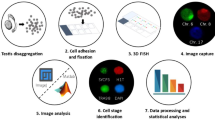Abstract
In order to reveal the time-course of decondensation of the Y chromosome in Sertoli cells, testes preparations of fetal, subadult and adult laboratory mice in different developmental stages were hybridized in situ with biotinylated probe pY353/B, which binds along the entire long arm of the mouse Y chromosome. All fetal and subadult testicular cells exhibited tightly compacted hybridization signals, indicating highly condensed Y chromosomes. Diffuse signals, indicating decondensation of the Y chromosome were found for the first time in the structurally differentiated Sertoli cells of 35 to 40 day old animals. Since this coincides with the appearance of mature sperm nuclei, a correlation between decondensation of the Y chromosome and its activity in sperm maturation and/or sperm motility can be presumed.
Similar content being viewed by others
References
Bishop CE, Boursot P, Baron B, Bonhomme F, Hatat D (1985) Most classical Mus musculus domesticus laboratory mouse strains carry a Mus musculus musculus Y chromosome. Nature 315:70–72
Brinkley BR, Brenner SL, Hall JM, Tousson A, Balczon RD, Valdivia MM (1986) Arrangement of kinetochores in mouse cells during meiosis and spermatogenesis. Chromosoma 94:309–317
Burgoyne PS, Buehr M, Koopman P, Rossant J, McLaren A (1988) Cell-autonomous action of the testis-determining gene: Sertoli cells are exclusively XY in XX ↔ XY chimaeric mouse testes. Development 102:443–450
Byskov AG (1986) Differentiation of mammalian embryonic gonad. Physiol Rev 66:71–117
Eicher EM, Washburn LL (1986) Genetic control of primary sex determination in mice. Annu Rev Genet 20:327–360
Feinberg AP, Vogelstein B (1984) A technique for radiolabeling DNA restriction endonuclease fragments to high specific activity. Addendum. Anal Biochem 137:266–267
Flickinger C (1967) The postnatal development of the Sertoli cells of the mouse. Z Zellforsch Mikrosk Anat 78:92–113
Griswold MD, Roberts K, Bishop P (1984) Purification and characterization of a sulfated glycoprotein secreted by Sertoli cells. Biochemistry 25:7265–7270
Gubbay J, Collignon J, Koopman P, Capel B, Economou A, Münsterberg A, Vivian N, Goodfellow P, Lovell-Badge R (1990) A gene mapping to the sex-determining region of the mouse Y chromosome is a member of a novel family of embryonically expressed genes. Nature 346:245–250
Guttenbach M, Schmid M, Jauch A, Vogt P (1989) The Y chromosome of the mouse is decondensed in Sertoli cells. Chromosoma 97:429–433
Hagenas L, Ritzen EM, Ploen L, Hansson VC, French FS, Nayfeh SN (1975) Sertoli cell origin of testicular androgen-binding protein. Mol Cell Endocrinol 2:339–350
Hsu TC, Cooper JEK, Mace ML Jr, Brinkley BR (1971) Arrangement of centromeres in mouse cells. Chromosoma 34:73–87
Huggenvik J, Sylvester SR, Griswold M (1984) Control of transferrin RNA synthesis in Sertoli cells. Ann NY Acad Sci 438:1–7
Krzanowska H (1976) Inheritance of sperm head abnormality types in mice — the role of the Y chromosome. Genet Res 28:189–198
Magre S, Jost A (1980) The initial phases of testicular organogenesis in the rat. An electron microscope study. Arch Anat Microsc Morphol Exp 69:297–318
McLaren (1984) Meiosis and differentiation of mouse germ cells. In: Evans CW, Dickinson HG (eds) 38th Symposium Society for Experimental Biology Controlling events in meiosis. Company of Biologists, Cambridge
Morales C, Hugly S, Griswold MD (1987) Stage-dependent levels of specific mRNA transcripts in Sertoli cells. Biol Reprod 36:1035–1046
Palmer SJ, Burgoyne PS (1991) In situ analysis of fetal, prepubertal and adult XX↔XY chimaeric mouse testes: Sertoli cells are predominantly, but not exclusively, XY. Development 112:265–268
Skinner MK, Griswold MD (1980) Sertoli cells synthesize and secrete transferrin-like protein. J Biol Chem 255:9523–9525
Speed RM, Vogt P, Köhler MR, Hargreave TB, Chandley AC (1993) Chromatin condensation behaviour of the Y chromosome in the human testis. I. Evidence for decondensation of distal Yq in germ cells prior to puberty with a switch to Sertoli cells in adults. Chromosoma 102:421–427
Sylvester SR, Griswold MD (1984) Localization of transferrin and transferrin receptors in rat testis. Biol Reprod 31:195–203
Sylvester SR, Skinner MK, Griswold MD (1984) A sulphated glycoprotein synthesized by Sertoli cells is a component of sperm membrane. Biol Reprod 31: 1087–1101
Wright WW, Parvinen M, Musto NA, Gunsalus GL, Phillips DM, Mather JP, Bardin CW (1983) Identification of stage-specific proteins synthesized by rat seminiferous tubules. Biol Reprod 29:257–270
Author information
Authors and Affiliations
Additional information
Communicated by: C. Heyting
Rights and permissions
About this article
Cite this article
Guttenbach, M., Winking, H. & Schmid, M. Organization of the Y chromosome in testis cells of fetal, subadult and adult mice as determined by in situ hybridization. Chromosoma 102, 618–622 (1993). https://doi.org/10.1007/BF00352309
Received:
Revised:
Accepted:
Issue Date:
DOI: https://doi.org/10.1007/BF00352309




